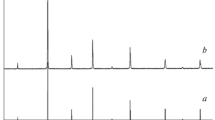Abstract
Mössbauer spectra were recorded at multiple temperatures between 80 and 293 K to study the nature of Fe3+ in Fe0.05Mg0.95SiO3 perovskite that had been synthesised in a multianvil press at 1650 °C and 25 GPa at its mimimum stability limit. The Mössbauer data were fitted to a model with quadrupole splitting distributions (Fe2+) and Lorentzian lineshapes (Fe3+ and Fen+). The centre shift data were fitted to a Debye model with the following results: ΘM (Fe2+)=365±52 K and ΘM (Fe3+)=476±96 K. Hyperfine parameter data for Fe3+ suggest occupation of the octahedral site only. The average valence seen by the Mössbauer effect in rapid electron exchange that occurs between Fe2+ and Fe3+ is calculated from the hyperfine parameters to be 2.50±0.07. Correction of area fractions for site-dependent recoil-free fractions gives a value for Fe3+/∑Fe of 9.4±1.4%, which is independent of temperature. A perovskite phase of similar composition synthesised in the multianvil press at higher oxygen fugacity gives a value for Fe3+/∑Fe of 16±3%, where Fe3+ appears to occupy both sites in the perovskite structure.
Similar content being viewed by others
Author information
Authors and Affiliations
Additional information
Received: 20 March 1997 / Revised, accepted: 26 September 1997
Rights and permissions
About this article
Cite this article
McCammon, C. The crystal chemistry of ferric iron in Fe0.05Mg0.95SiO3 perovskite as determined by Mössbauer spectroscopy in the temperature range 80–293 K. Phys Chem Min 25, 292–300 (1998). https://doi.org/10.1007/s002690050117
Issue Date:
DOI: https://doi.org/10.1007/s002690050117



